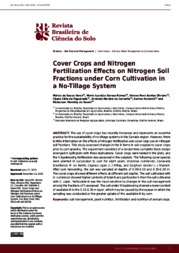Cover crops and nitrogen fertilization effects on nitrogen soil fractions under corn cultivation in a no-tillage system.
Cover crops and nitrogen fertilization effects on nitrogen soil fractions under corn cultivation in a no-tillage system.
Autoria: VERAS, M. de S.; RAMOS, M. L. G.; OLIVEIRA, D. N. S.; FIGUEIREDO, C. C. de; CARVALHO, A. M. de; PULROLNIK, K.; SOUZA, K. W. de
Resumo: ABSTRACT: The use of cover crops has recently increased and represents an essential practice for the sustainability of no-tillage systems in the Cerrado region. However, there is little information on the effects of nitrogen fertilization and cover crop use on nitrogen soil fractions. This study assessed changes in the N forms in soil cropped to cover crops prior to corn growing. The experiment consisted of a randomized complete block design arranged in split-plots with three replications. Cover crops were tested in the plots, and the N topdressing fertilization was assessed in the subplots. The following cover species were planted in succession to corn for eight years: Urochloa ruziziensis, Canavalia brasiliensis M. ex Benth, Cajanus cajan (L.) Millsp, and Sorghum bicolor (L.) Moench. After corn harvesting, the soil was sampled at depths of 0.00-0.10 and 0.10-0.20 m. The cover crops showed different effects at different soil depths. The soil cultivated with U. ruziziensis showed higher contents of total-N and particulate-N than the soil cultivated with C. cajan. Particulate-N was the most sensitive to changes in the soil management among the fractions of N assessed. The soil under N topdressing showed a lower content of available-N in the 0.10-0.20 m layer, which may be caused by the season in which the sampling was conducted or the greater uptake of the available-N by corn.
Ano de publicação: 2016
Tipo de publicação: Artigo de periódico
Unidade: Embrapa Cerrados
Observações
1 - Por padrão são exibidas publicações dos últimos 20 anos. Para encontrar publicações mais antigas, configure o filtro ano de publicação, colocando o ano a partir do qual você deseja encontrar publicações. O filtro está na coluna da esquerda na busca acima.
2 - Para ler algumas publicações da Embrapa (apenas as que estão em formato ePub), é necessário ter, no celular ou computador, um desses softwares gratuitos. Sistemas Android: Google Play Livros; IOS: iBooks; Windows e Linux: software Calibre.
Acesse outras publicações
Acesse a Base de Dados da Pesquisa Agropecuária (BDPA) para consultar o acervo completo das bibliotecas da Embrapa.

